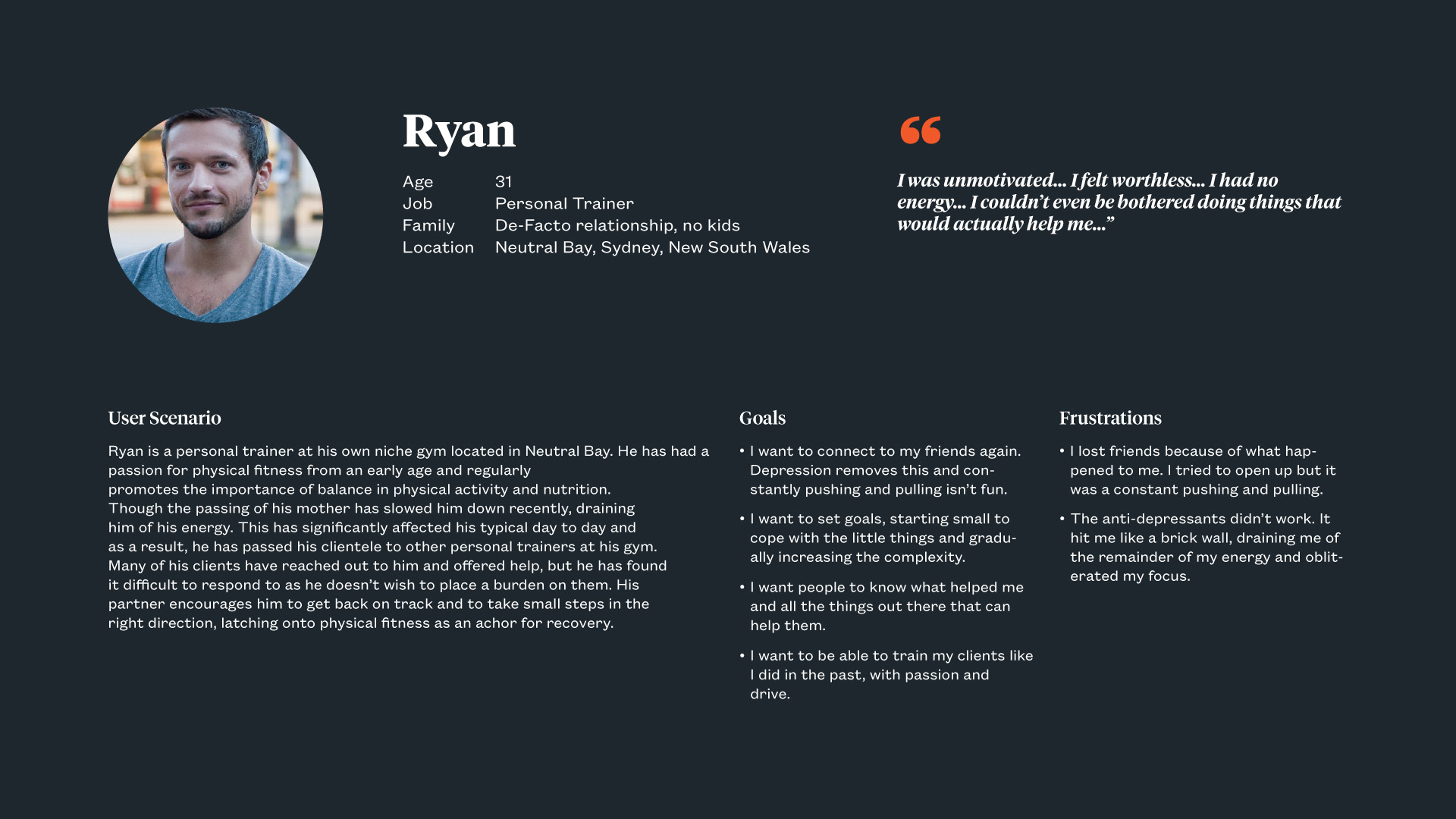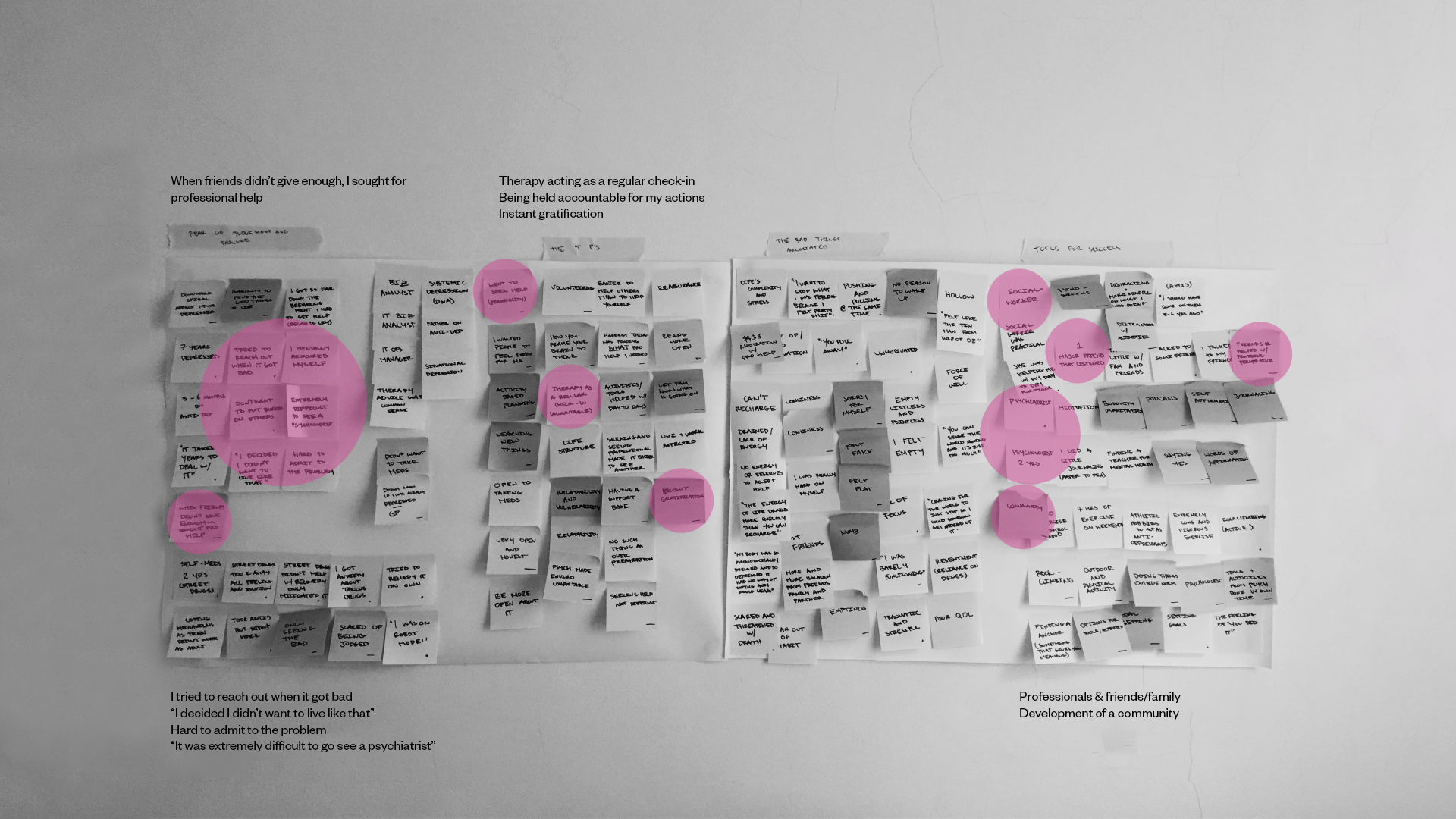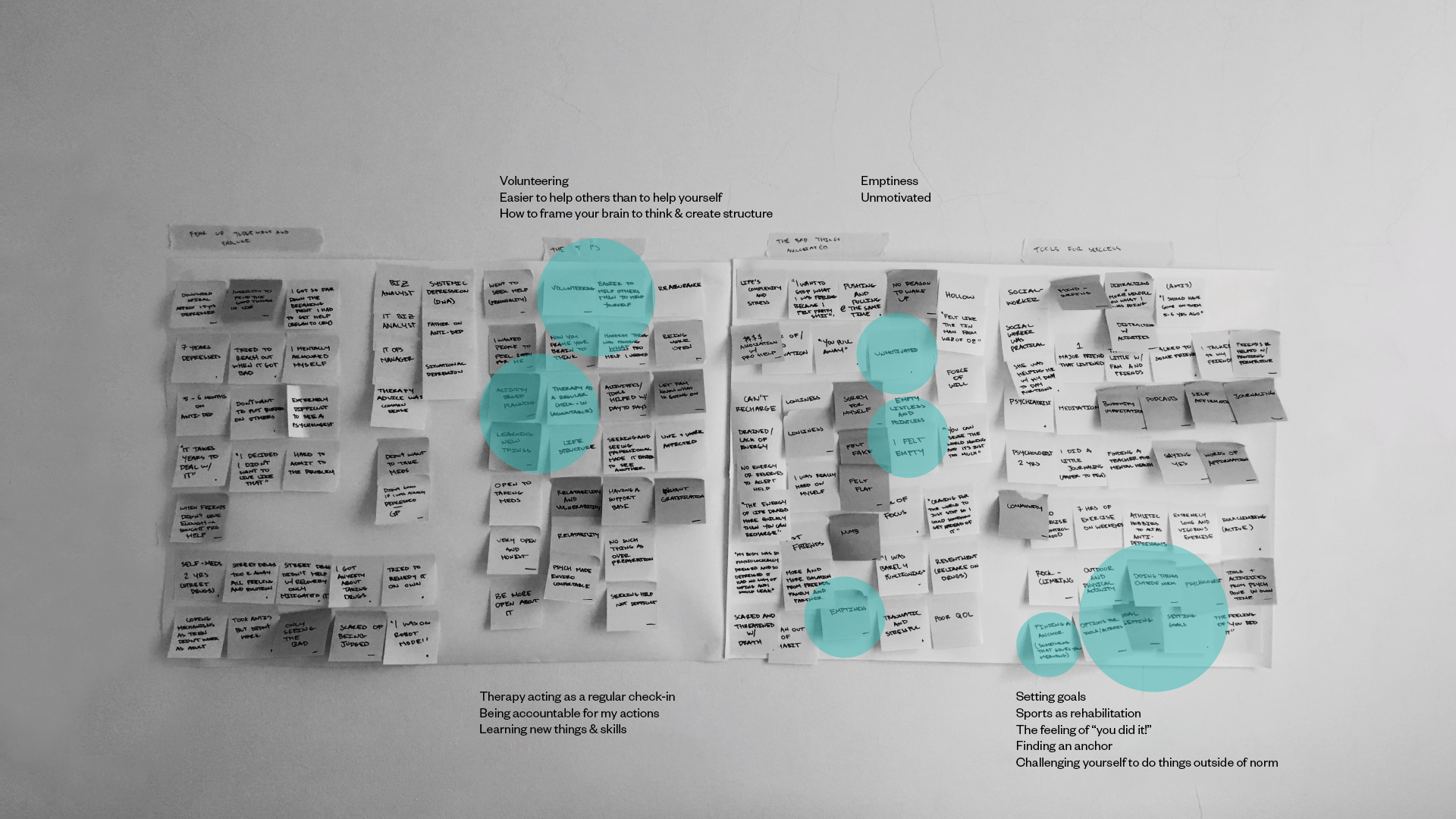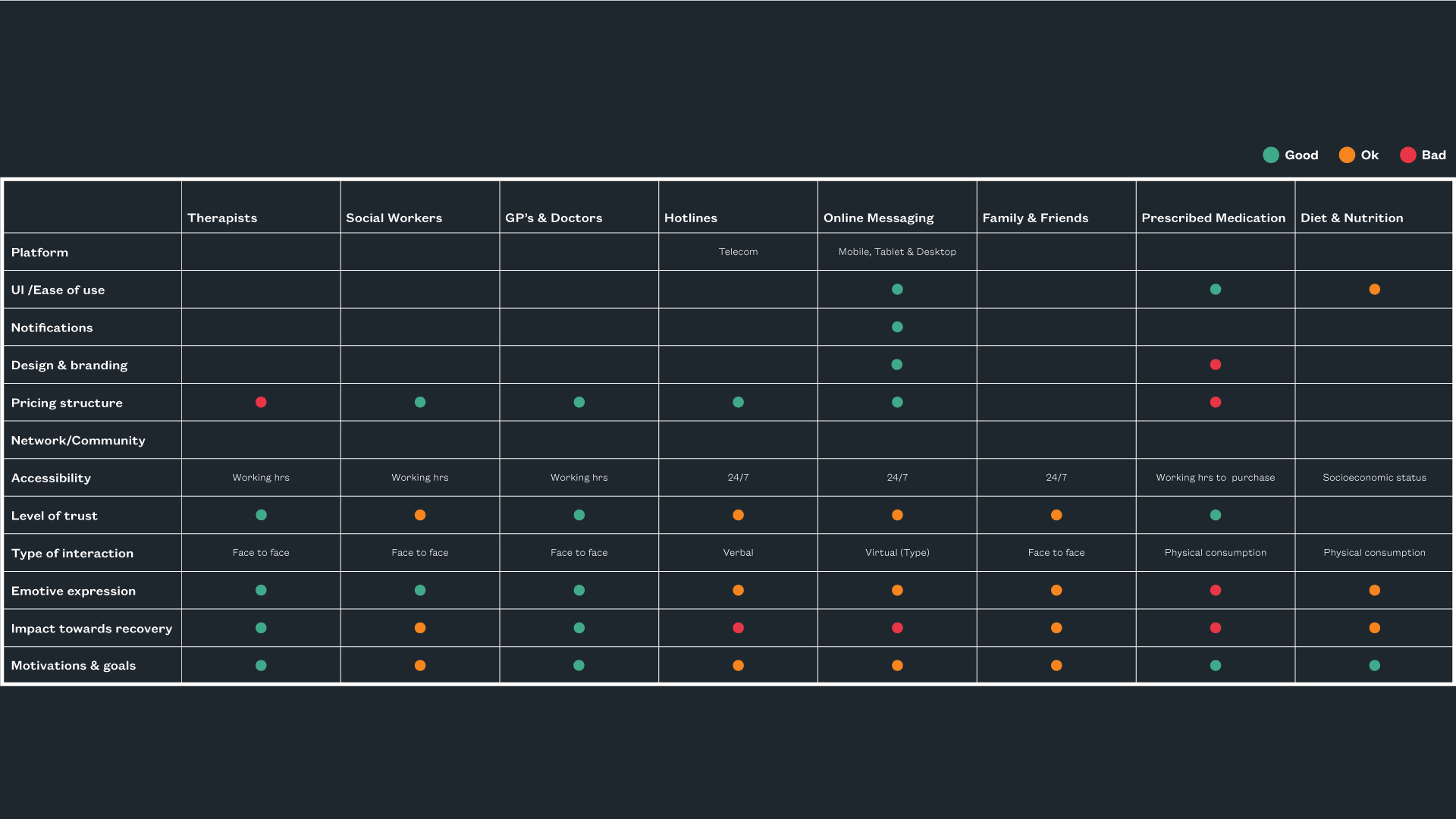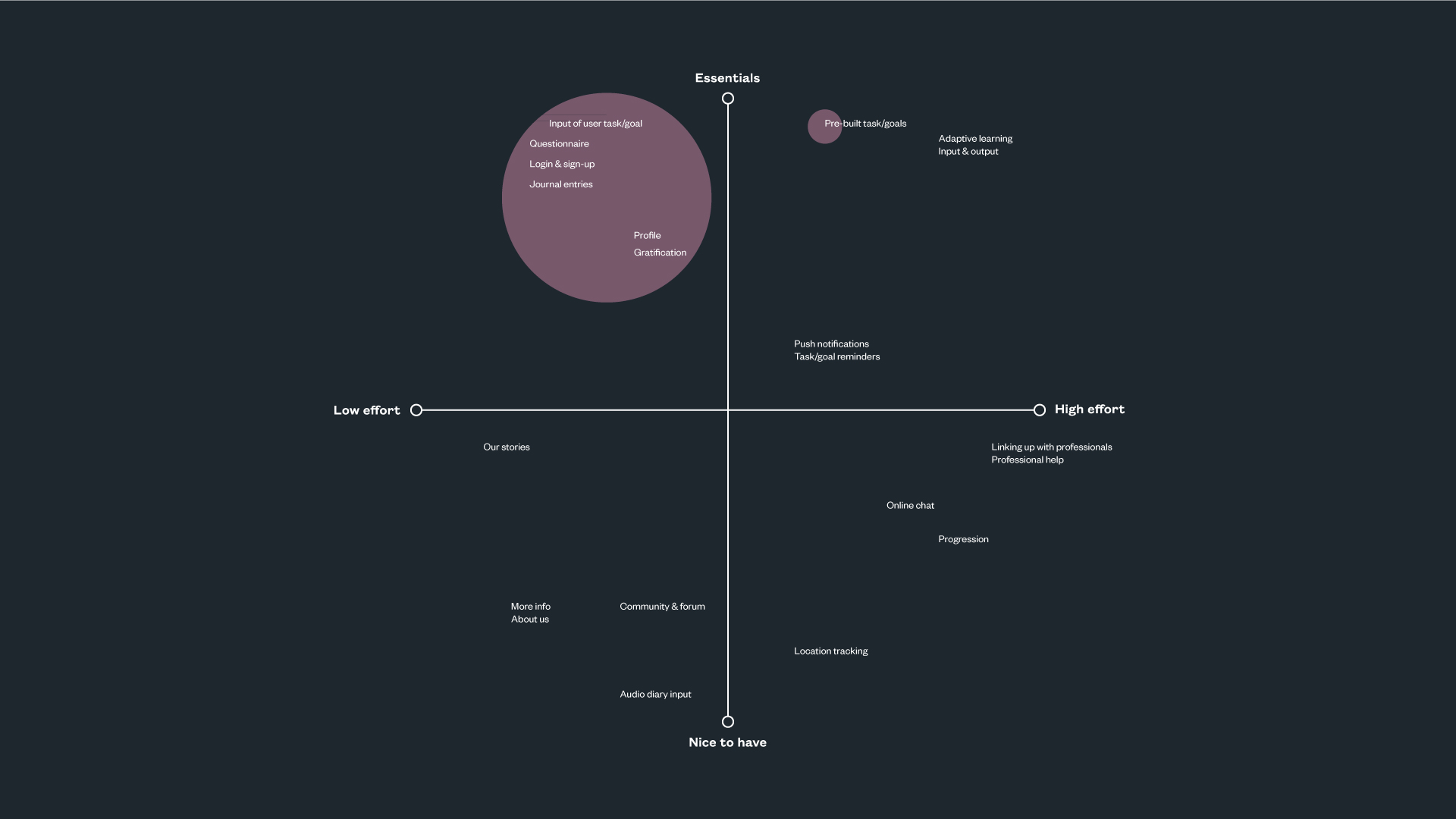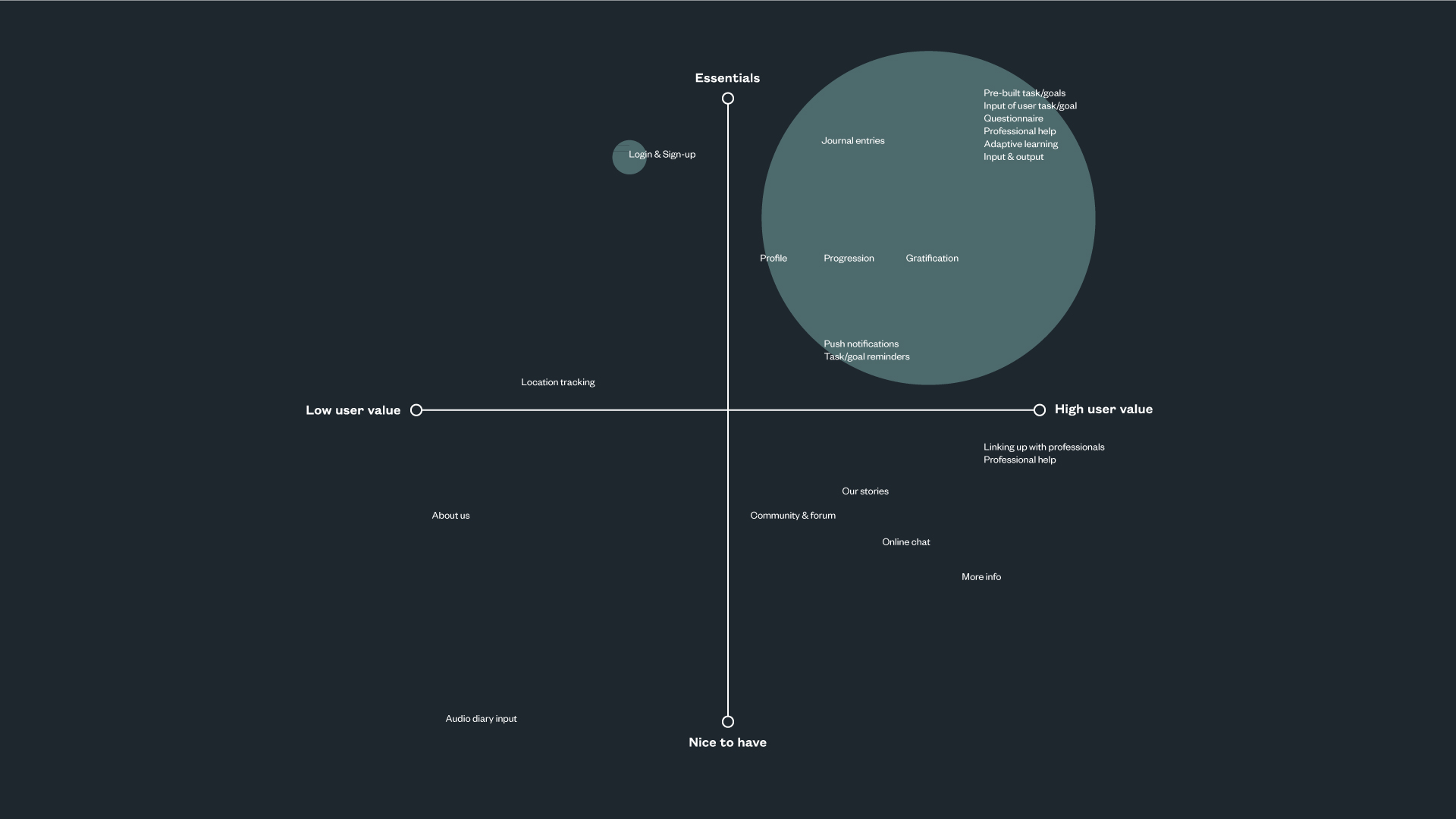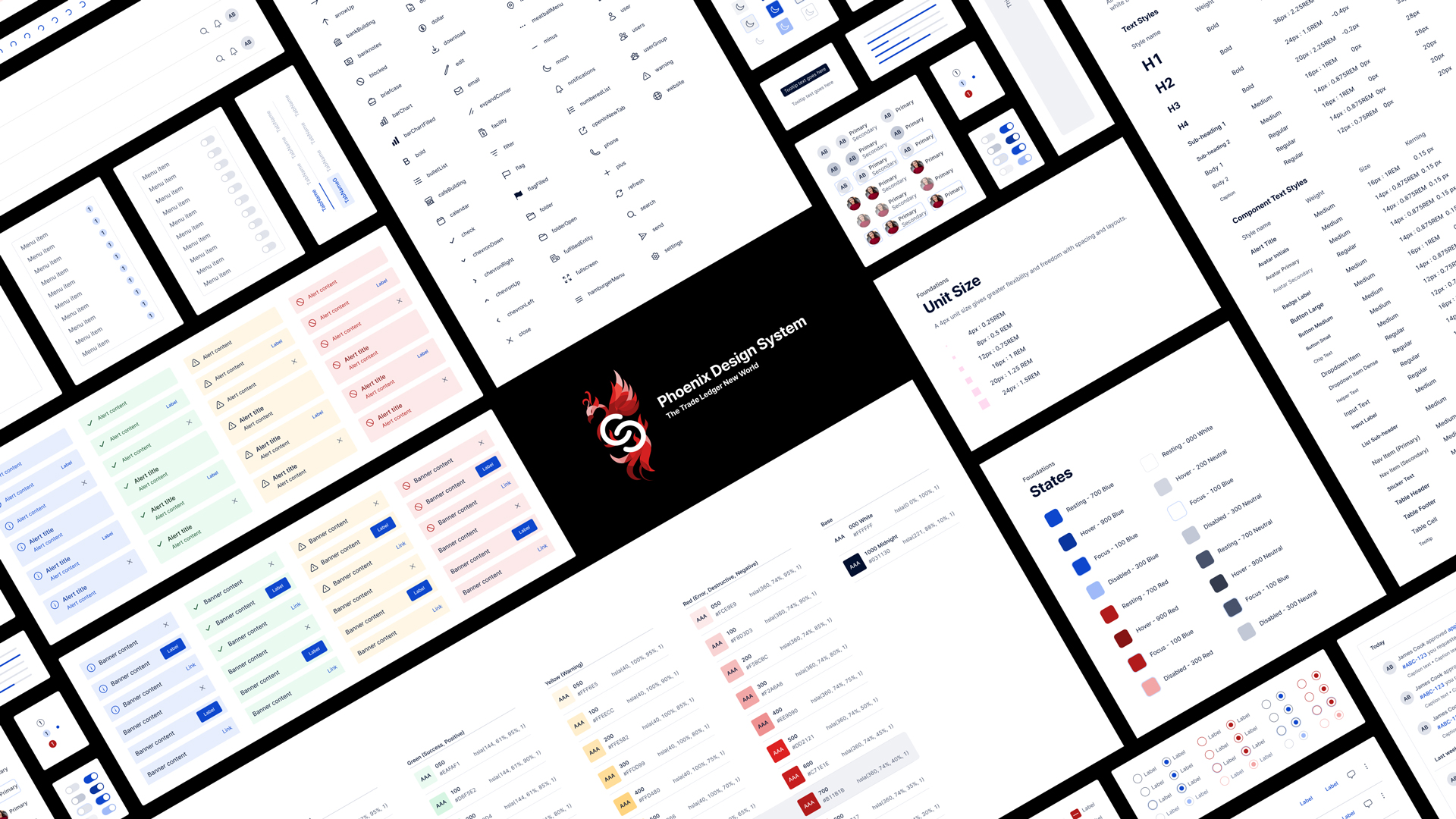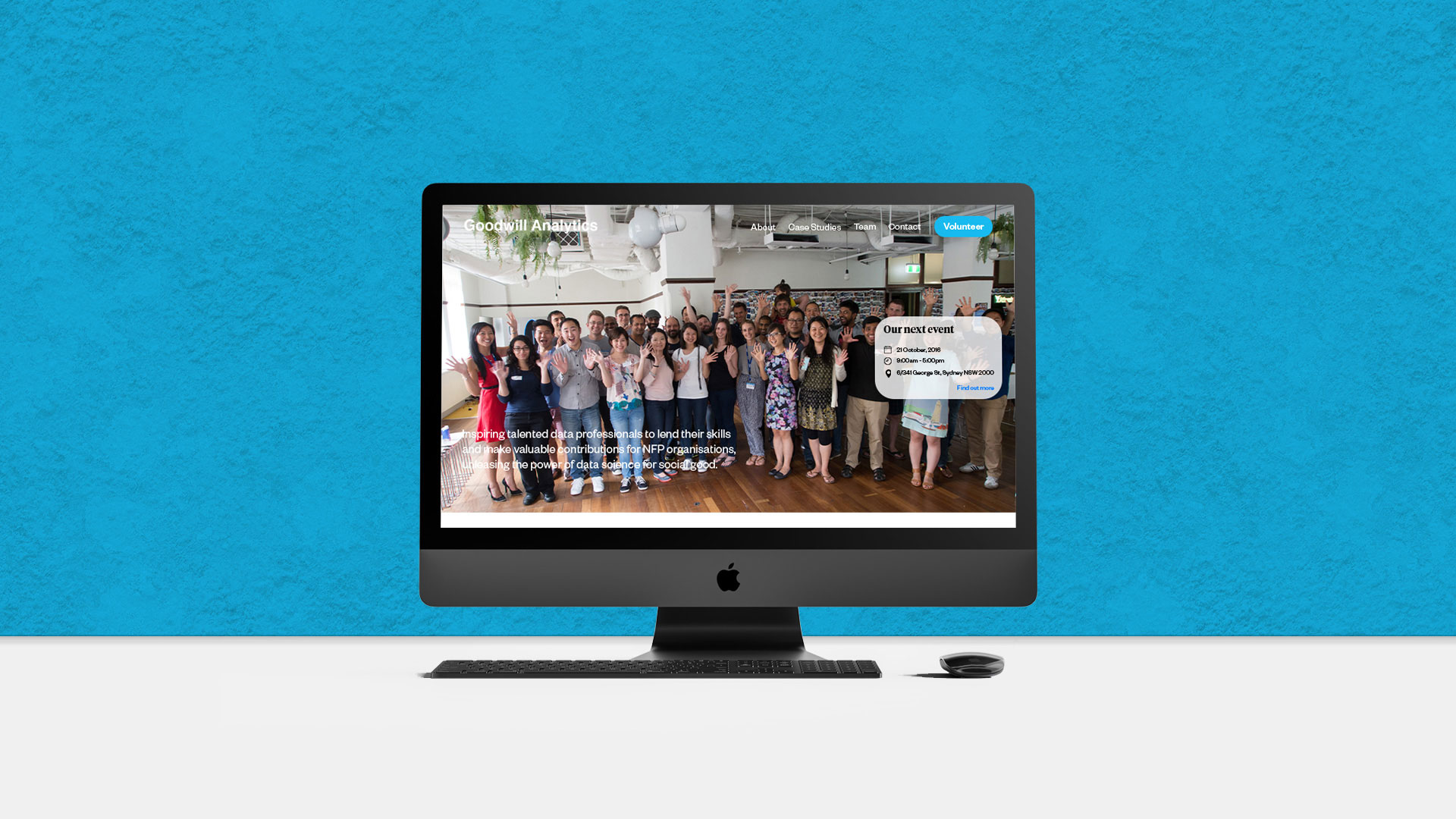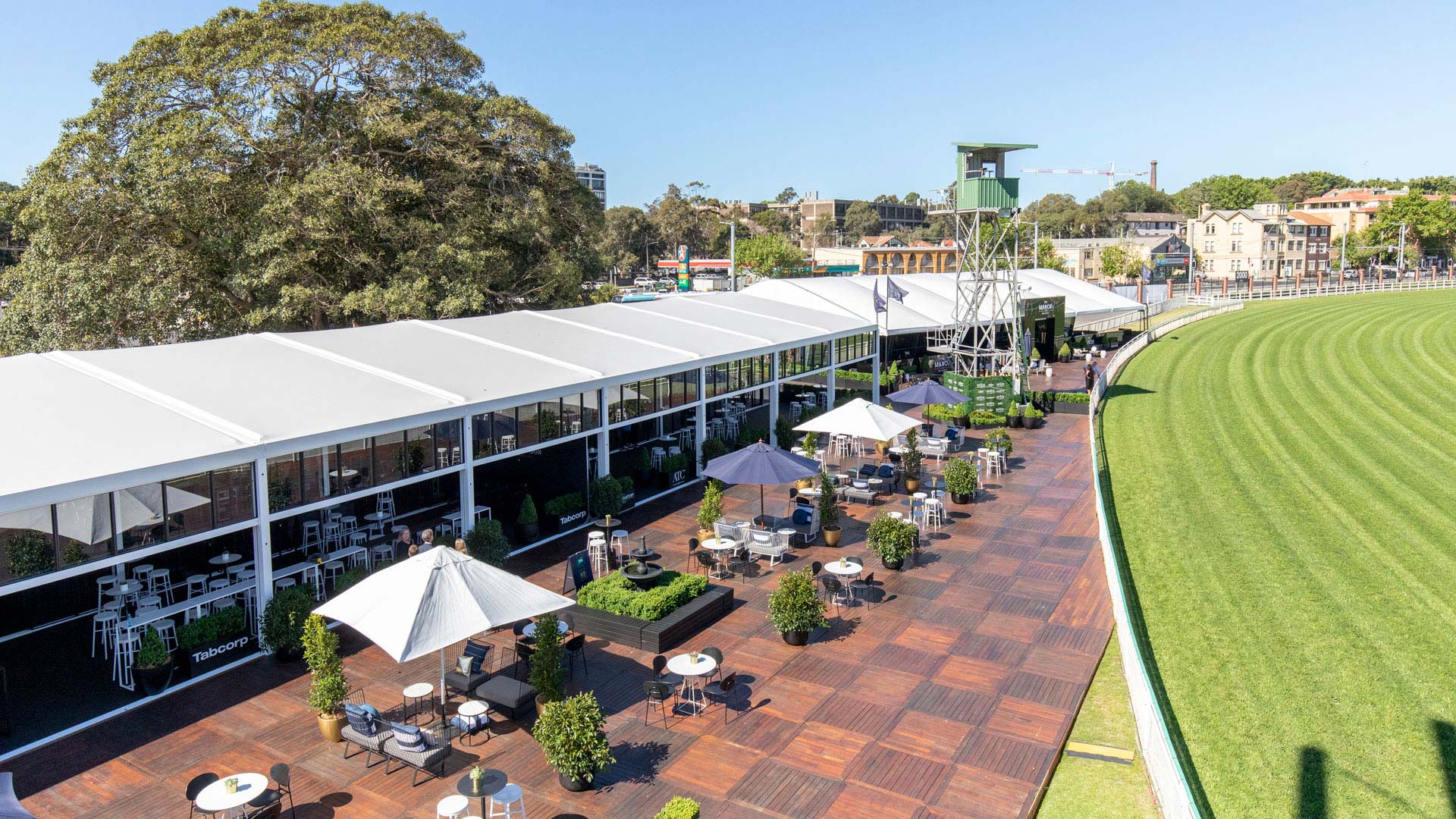Client
Personal Project
Date
2020
Duration
5 weeks
Collaborators
Thank you to the participants in this project
UX and UI — Depression
Depression is a serious mental illness and in early 2011, I was diagnosed with mild depression. It was only until late 2012 I managed to recover from this. Given my personal experience of depression I realised how arduous, lonely and difficult the journey can be. During this period of time, I had no energy, no self respect and couldn't even form the courage to consult my peers or professional therapists in the fear of burdening them with my own problems — at the end of the day, there was only emptiness.
Several years later I decided to look further into this mental illness and devise a solution which I believe could help others in the road to recovery.
My Mission
Provide a platform that enables individuals with depression to progressively improve their quality of life (QOL) through the implementation of cognitive and behavioural strategies, that is, setting goals and achieving them in the road to recovery.
My Challenge
Creating a service or platform that compliments professional therapy by engaging individuals who suffer from depression to take gradual goal orientated steps towards recovery and building confidence in seeking professional help when needed.

The Purpose and Approach
Depression is a mental illness that impacts approximately 45% or 7.5 million of all Australians aged between 16-85. Of this, only 34% or 2.6 million seek professional treatment, whilst 1 in 4 men do not seek professional treatment at all. (Source: Australian Bureau of Statistics)
My approach to this project aimed to address these three key areas.
1. Creating an individualised roadmap to recovery based on the circumstances and severity of depression.
2. Opening and increasing the use of professional therapy and/or peer assistance despite the negative stigmas associated against it.
3. The removal or reduction of the financial burden associated with professional therapy.
To achieve this, I believed that perhaps through behavioural and cognitive strategies, that is, providing users with specific goals which gradually increased or decreased in complexity, could act as a catalyst towards recovery, resulting in a domino effect in which subsequently enables individuals to feel a sense of accomplishment, motivation and gratitude. Additionally, the product would aim to complement existing products, tools and services that are currently available such as medication, professional therapy, meditation, hotlines etc.

Project Critical Behaviours
Prior to conducting user research I needed to clearly define the users of the product, as well as understand the structure behind the stages of depression and grief.
The users were defined as the following:
1. The Helper
Any individual or group who is involved with the recovery process. This may be a member of the family, a friend, a professional, a service etc
2. The Depressed (Primary Focus)
An individual who is in a mental condition which is characterized by feelings of severe despondency and dejection, typically also coupled with feelings of inadequacy and guilt, and often accompanied by a lack of energy and disturbance of appetite and sleep
3. The Inducer
An individual, a scenario, an event or predisposed DNA in which acts as a catalyst for depression
Validation – User Interviews
To validate the projects approach, user interviews were conducted with participants that aligned with the following scope.
Scope inclusions:
Sex: Male and Female
Age Group: 20 - 45 years old
Medication History: Have utilized and have not (prescribed medication and/or self-medication through the use of other substances)
Depression Catalyst: Varied (at least one individual with systemic/history of depression)
Professional Assistance: Have utilized and have not
User Interview Notes:
Due to the emotional distress user interviews could cause, 3 out of 7 individuals chose not to participate.
All user interviews conducted took approximately 45 minutes to 1 hour to complete.
All participants involved had no prior affiliation with me in the past.
All participants had varying catalysts which evoked the onset of depression.
It is also important to note that during the user interviews, 3 out of 4 participants required some time throughout the interview to gather their emotions in order to proceed, providing insight into how incredibly difficult it is to truly recover or be in the process of recovering from depression.
Information Synthesis – Affinity Mapping and Personas
Affinity mapping was utilized to synthesize the information gathered through user interviews. This teased out a myriad of key insights which aided in validating the projects approach as well as enabling the development of two personas that would assist in shaping the end product outcome.
Key insights teased out were the following:
1. Having an anchor
2. Accountability
3. Motivation and achievable goal setting
4. Communication and accessibility
5. The stigma associated against professional therapy and other services
6. The cost associated with professional therapy
7. Understanding the different types of professional therapy
Competitor Analysis
A competitor analysis was conducted to further validate a pathway for product development by addressing the potential shortcomings of existing products and services. The analysis compared direct and indirect products and services against the insights teased out through data synthesis as well as conventional design principles associated with app development. Investigation into the market outlined four possible areas that could be addressed due to the disparity between physical services, prescribed medication and digital products.
1. Pricing Structure
What are the costs associated with existing products or services?
Is this cost an up-front fee, subscription based or instalments?
Do these pricing methods unlock any additional features?
How could I remove or dramatically reduce this fee but still retain the positive impact towards recovery that professional therapy services yield? (This would allow for broader accessibility and enable less financially advantageous individuals to have access to a product)
2. Accessibility
Can these products and services be utilized at any given time of the day?
How accessible is the product or service financially and how do non-financially advantageous individuals use these products and services?
Some countries have further progressed health care systems than others, how does this impact the accessibility of products and services?
How does accessibility to the product and service weigh out in long term benefits?
Typically, professional therapy services can only be accessed during specific hours of the day and often require an appointment and/or referral. How could I create a product that enabled users to have contact with a professional therapy service 24 hours a day? Would this even be possible to achieve?
3. Impact towards recovery
How do available products and services yield in long term recovery?
Do these products and services provide merely the foundation towards recovery and rely on intrinsic motivation or do they exceed this and provide further support in order to avoid relapse?
Professional therapy yields an extremely high positive impact towards recovery, how could we pair depressed individuals with the right therapist whilst also providing them with the knowledge as to why?
What are the differences in terms of effectiveness both short term and long term from a digital product vs a physical service?
Professional therapists often prescribe patients with activities and goals which are focused on behavioural and cognitive strategies for long term recovery. How could these techniques be used on a digital platform yet yield similar if not better outcomes.
How do we also enable individuals to open up about their history and root cause of their depression? and with this, how could we leverage this information to create a tailored approach for each individual? (a "machine learning" approach could possibly be used to continue to improve long term benefits in recovery).
4. Motivation and goals
How is each individual motivated? Are they intrinsically motivated or motivated under pressure and deadlines?
Depression really drains the energy out of most individuals who suffer from it, this can often lead to incomplete activities of daily living (ADL's) which results in poor general hygiene practices, poor nutrition and minimal physical activity.
How could the product motivate and encourage users to be responsible for their ADL's as well as other goals they wished to achieve prior to the onset of their depression? How could the product improve their quality of life (QOL) in both the short term and long term?
Perhaps there is an opportunity here that utilizes the behavioural and cognitive strategies commonly prescribed by therapists in a digital space whilst also taking consideration into their current mood and mental state whilst using the application. Tasks and activities prescribed would vary in response to their inputted mood and mental state as well as their location, occupation and hobbies. Feedback mechanisms would also be integrated, nudging individuals in a positive direction and creating this "anchor" that so many people need.
Feature Prioritization - Essentials vs Effort to build
To begin development, a feature matrix was created to roadmap the desirability, feasibility, viability and effort to build of each element proposed within the design. The decisions made behind this were driven from the key insights found through information synthesis as well as the potential gaps within the market. This ultimately led to a product which primarily focused on the implementation of behavioural and cognitive strategies commonly prescribed by professional therapists. Additionally, users would also be able to input their own tasks and goals, adding another layer of accomplishment, self-gratification and motivation upon completion.
Wireframing and Prototyping
Moving forward with the design, I began exploring the possible screens through sketching and paper prototyping. These designs were transitioned into lo-fi digital wireframes and printed, allowing me to conduct user testing to further refine, review and further validate the design in its infancy.

Testing and Refining the MVP
User testing brought out considerations that would further enhance the overall product experience. These ideas were explored in the next iteration of prototyping and included the following:
1. Providing information on the benefits of the pre-loaded tasks and what they aim to achieve
2. Completion of task required to be more obvious instead of the accordion approach
3. Creating a more personal and inviting product
4. Lightning interactions for tasks such as "call mum"
5. Tracking of progress
6. Finding the right professional and how they can help
7. Gratification, gratification, gratification
8. Gamification
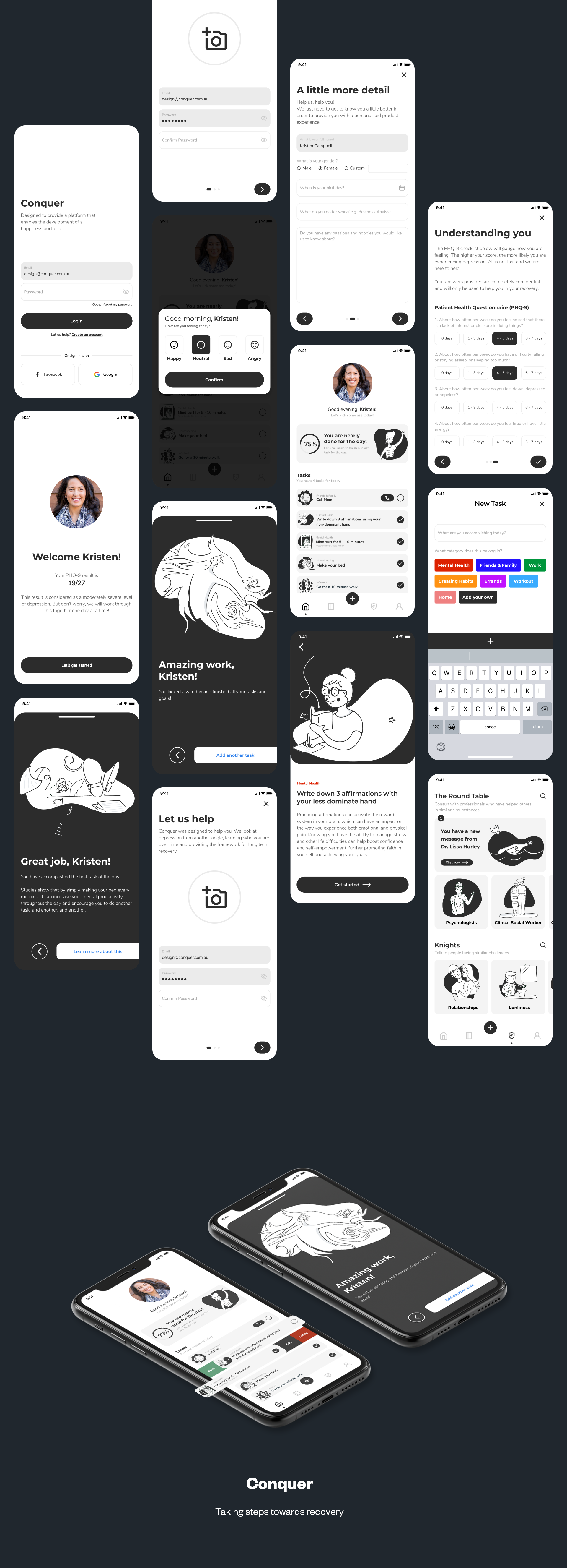
"Depression is such a cruel punishment. There are no fevers, no rashes, no blood tests to send people scurrying in concern, just the slow erosion of self, as insidious as cancer. And like cancer, it is essentially a solitary experience; a room in hell with only your name on the door"
Martha Manning
Author of Undercurrents: A Life Beneath the Surface
Next Steps..
So what are my next steps?
- Integration of an on-boarding experience to the landing page enabling the user to input their mood, a task and completion of task.
- Providing further clarity and resources to define why these pre-defined tasks are valuable and what they do to assist mentally. Evidence will be provided from scientific studies and referenced back.
- Further development of additional features and their interactions with the app. (ie. Progress tracking, diary entries, connecting with professionals or peers)
- Providing the framework and parameters for adaptive learning.
- Development of a high-fidelity prototype with a style guide.
- Further testing with multiple user groups to assess behaviour and review long term use and its benefits.
- Analysis of developed features to determine how users behave and react. (Does progression tracking cause anxiety, do incomplete tasks cause frustration etc)
- Gamification. (Could progression tracking be converted into a game? ie. Growing a tree) - A/B testing of this.

